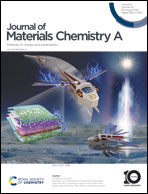Rapid and selective removal of toxic and radioactive anionic pollutants using an ionic covalent organic framework (iCOF-2)†
Abstract
The main contaminants in aqueous solutions that bio-magnify in living organisms include (but are not limited to) heavy metal-based toxic oxo-anions (CrO42−, MnO4−, ReO4−, HAsO4−etc.), anionic radioactive pollutants (such as 129I−, 99TcO4−, 79SeO32−, 79SeO42−, etc.), and organic pollutants (including polycyclic aromatic hydrocarbons [PAHs] and pharmaceuticals) that are often generated as industrial waste. These pollutants pose serious health hazards to humans and other animals upon passing through their respective food chains. This report details the design of a new ionic covalent organic framework (iCOF-2) obtained via a facile Schiff base reaction for efficient and selective capture of certain radioactive species and other metal based pollutants (such as oxo-anions) that are often present in industrial effluents. Desired qualities such as a charged and porous framework as well as excellent radiation and physicochemical stabilities present in iCOF-2 render this material a viable adsorbent for removal of hazardous pollutants in an economical and ecologically safe manner. iCOF-2 demonstrates extremely fast sieving kinetics for various oxo-anions and other inorganic radioactive/organic pollutants. Simultaneously, iCOF-2 also exhibits a high capture capacity for ReO4− (325 mg g−1), I3− (1705 mg g−1), MnO4− (334 mg g−1), CrO42− (253 mg g−1), and diclofenac (235 mg g−1). The distribution coefficient (Kd) is greater than 104 mg L−1, which is one of the prime criteria expected in a superior adsorbate material. iCOF-2 also demonstrates good selectivity in the presence of other interfering anions with high removal efficacy (>90%). iCOF-2 can also capture toxic anionic pollutants present in various water samples such as underground water (tap water) and surface water (river, sea, lake and pond) with rapid sequestration efficiency. iCOF-2 can be reused for at least five regeneration cycles without any appreciable decrease in its pollutant removal efficiency.

- This article is part of the themed collection: #MyFirstJMCA


 Please wait while we load your content...
Please wait while we load your content...